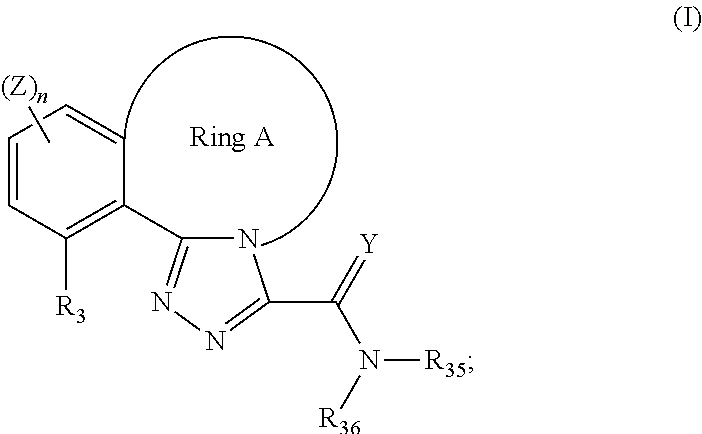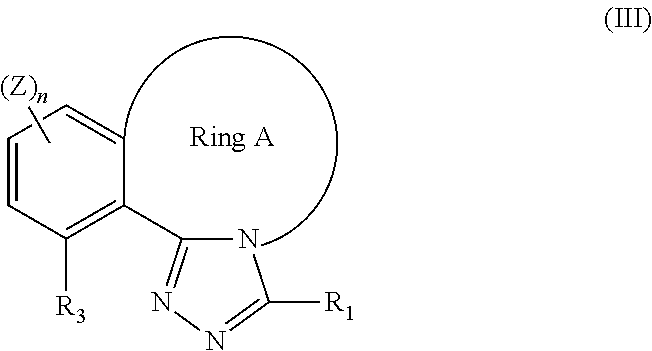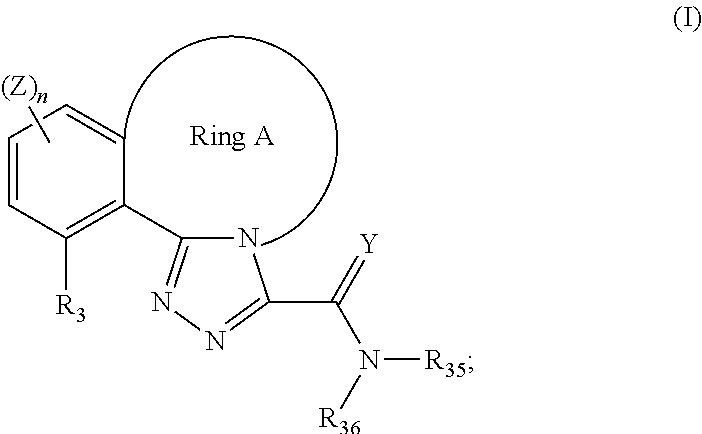Tricyclic triazole compounds that modulate hsp90 activity
a triazole and activity technology, applied in the field of tricyclic triazole compounds that modulate hsp90 activity, can solve the problems of unsatisfactory current chemotherapy, unfavorable treatment effect of majority of patients diagnosed with cancer, and inability to fully implement a therapeutic agent that acts on one molecular targ
- Summary
- Abstract
- Description
- Claims
- Application Information
AI Technical Summary
Benefits of technology
Problems solved by technology
Method used
Image
Examples
example 1
A. Eight-Membered Ring Systems
[0373]
Compound 1: (Z)-10,12-dimethoxy-5,8-dihydrobenzo[c][1,2,4]triazolo[4,3-a]azocine-3-carboxamide
[0374]1-Allyl-3,5-dimethoxybenzene (2). To a stirred solution of 1.49 g (16.5 mmol) of copper (I) cyanide and 1.39 g (33 mmol) of lithium chloride in 40 mL of THF was added dropwise 15 mL of a 1 M solution of 3,5-dimethoxyphenylmagnesium chloride in THF at −78° C. After stirring for 5 min, 2.5 mL (3.6 g, 30 mmol) of allyl bromide was added dropwise, and the resulting solution was stirred for 16 h while slowly warming to room temperature. The reaction mixture was quenched by slowly adding saturated NH4Cl(aq) and stirring for 5 min. The layers were separated and the aqueous phase was extracted three times with 50-mL portions ethyl acetate. The combined organic fractions were dried (Na2SO4), filtered through a pad of silica gel (eluted with ethyl acetate) and concentrated in vacuo. The residue was chromatographed over silica gel (eluted with 50:1 hexanes-eth...
example 2
Inhibition of Hsp90
[0397]Hsp90 protein is obtained from Stressgen (Cat#SPP-770). Assay buffer: 100 mM Tris-HCl, Ph7.4, 20 mM KCl, 6 mM MgCl2. Malachite green (0.0812% w / v) (M9636) and polyvinyl alcohol USP (2.32% w / v) (P1097) are obtained from Sigma. A Malachite Green Assay (see Methods Mol Med, 2003, 85:149 for method details) is used for examination of ATPase activity of Hsp90 protein. Briefly, Hsp90 protein in assay buffer (100 mM Tris-HCl, Ph7.4, 20 mM KCl, 6 mM MgCl2) is mixed with ATP alone (negative control) or in the presence of Geldanamycin (a positive control) or a compound of the invention in a 96-well plate.
[0398]Malachite green reagent is added to the reaction. The mixtures are incubated at 37° C. for 4 hours and sodium citrate buffer (34% w / v sodium citrate) is added to the reaction. The plate is read by an ELISA reader with an absorbance at 620 nm.
example 3
Degradation of Hsp90 Client Proteins via Inhibition of Hsp90 Activity
[0399]A. Cells and Cell Culture
[0400]Human high-Her2 breast carcinoma BT474 (HTB-20), SK-BR-3 (HTB-30) and MCF-7 breast carcinoma (HTB-22) from American Type Culture Collection, VA, USA were grown in Dulbecco's modified Eagle's medium with 4 mM L-glutamine and antibiotics (100 IU / ml penicillin and 100 μg / ml streptomycine;GibcoBRL). To obtain exponential cell growth, cells were trypsinized, counted and seeded at a cell density of 0.5×106 cells / ml regularly, every 3 days. All experiments were performed on day 1 after cell passage.
[0401]B. Degradation of Her2 in Cells after Treatment with a Compound of the Invention
[0402]1) Method 1
[0403]BT-474 cells are treated with 0.5 μM, 2 μM, or 5 μM of 17AAG (a positive control) or 0.5 μM, 2 μM, or 5 μM of a compound of the invention overnight in DMEM medium. After treatment, each cytoplasmic sample is prepared from 1×106 cells by incubation of cell lysis buffer (#9803, cell Sig...
PUM
| Property | Measurement | Unit |
|---|---|---|
| Fraction | aaaaa | aaaaa |
| Dimensionless property | aaaaa | aaaaa |
| Dimensionless property | aaaaa | aaaaa |
Abstract
Description
Claims
Application Information
 Login to View More
Login to View More - R&D
- Intellectual Property
- Life Sciences
- Materials
- Tech Scout
- Unparalleled Data Quality
- Higher Quality Content
- 60% Fewer Hallucinations
Browse by: Latest US Patents, China's latest patents, Technical Efficacy Thesaurus, Application Domain, Technology Topic, Popular Technical Reports.
© 2025 PatSnap. All rights reserved.Legal|Privacy policy|Modern Slavery Act Transparency Statement|Sitemap|About US| Contact US: help@patsnap.com



